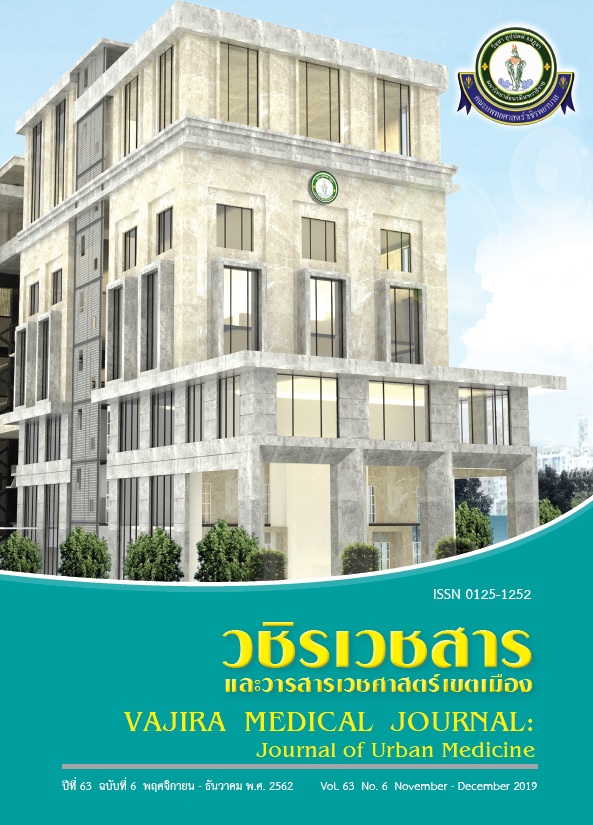Efficacy and safety of brand-to-generic Tamsulosin for treating lower urinary tract symptoms associated with benign prostatic hyperplasia; A randomized, non-inferiority study
Main Article Content
Abstract
Objective: To compare the efficacy and safety of Uroflow (Mega, Thailand) and Harnal (Astellas Pharma, Thailand) for treating lower urinary tract symptoms associated with benign prostatic hyperplasia (BPH)
Methods: This is a randomized, non-inferiority study in 180 patients who have Lower Urinary Tract Symptoms (LUTS) and International Prostatic Symptom Score (IPSS) more than 7. We randomly assigned patients to receive either Uroflow or Harnal for 12 weeks. All data was collected at baseline, the 4th week and the 12th weeks. The primary outcome was the mean change in IPSS from baseline to the endpoint. Secondary outcomes were the mean change in IPSS subscore, Qaulity of Life (QoL), maximum uroflowmetry (Qmax), Post Voiding Residuals (PVR) and adverse event of tamsulosin.
Results: 180 patients were randomly assigned into two groups (90 Uroflow, 90 Harnal). The mean changes in IPSS from baseline in Uroflow and Harnal-treated groups were -8.81±6.92 and -8.47±5.91, respectively. There was a statistically significant improvement in both groups. The mean difference (Uroflow- Harnal) was 0.34 (with a two-side 90% confidence interval), inferring that Uroflow was not inferior to Harnal. The mean change in IPSS subscore, QoL, Qmax, PVR were comparable between both groups. The incidence of adverse event were not significantly different.
Conclusions: The results of this study show that Uroflow is not inferior to Harnal in the treatment of patients with LUTS associated with BPH.
Downloads
Article Details
References
Roberts RO, Rhodes T, Panser LA, et al. Natural history of prostatism: worry and embarrassment from urinary symptoms and health care-seeking behavior. Urology 1994b;43:621.
Kaplan SA. Update on the American Urological Association guidelines for the treatment of benign prostatic hyperplasia. Rev Urol 2006;8[Suppl.4]:S10–7.
Oelke M,Bachmann A, Descazeaud A,Emberton M, Gravas S,Michel MC, et al. Guidelines on the treatment of non-neurogenic Male LUTS. European Association of Urology;2011.
Wilt TJ, MacDonald R, Nelson D. Tamsulosin for treating lower urinary tract symptoms compatible with benign prostatic obstruction: a systematic review of efficacy and adverse effects. J Urol 2002b;167(1):177–83.
Lee HS, Kim SW, Oh SJ, Choo MS, Lee KS. Efficacy and safety of tamsulosin for treating lower urinary tract symptoms associated with benign prostatic hyperplasia: a multicenter, randomized, controlled, open-label noninferiority study. Korean J Urol. 2012 Mar;53(3):178-83. doi: 10.4111/kju.2012.53.3.178. Epub 2012 Mar 19.
Barry MJ, Williford WO, Change Y, Machi M, Jones KM, Walker-Corkey E, et al. Benign prostatic hyperplasia specific health status measures in clinical research: how much change in the American Urological Association symptom index and the benign prostatic hyperplasia impact index is perceptible to patients? J Urol 1995;154:1770-4.
Lepor H. The role of alpha blockage in the treatment of BPH. In: Lepor H, Lawson R, editors. Prostatic diseases. Philadelphia: Saunders; 1993.p. 170–81.
Narayan P, Tewari A. A second phase III multicenter placebo controlled study of 2 dosages of modified release tamsulosin in patients with symptoms of benign prostatic hyperplasia. United States 93-01 Study Group. J Urol 1998;160(5):1701–6.
Chow,S.-C.,Shao,.,& Wang,H.(2003).Sample Size Calculation in Clinical research (2nd ed.) Chapman&Hall/CRC.,59p.


